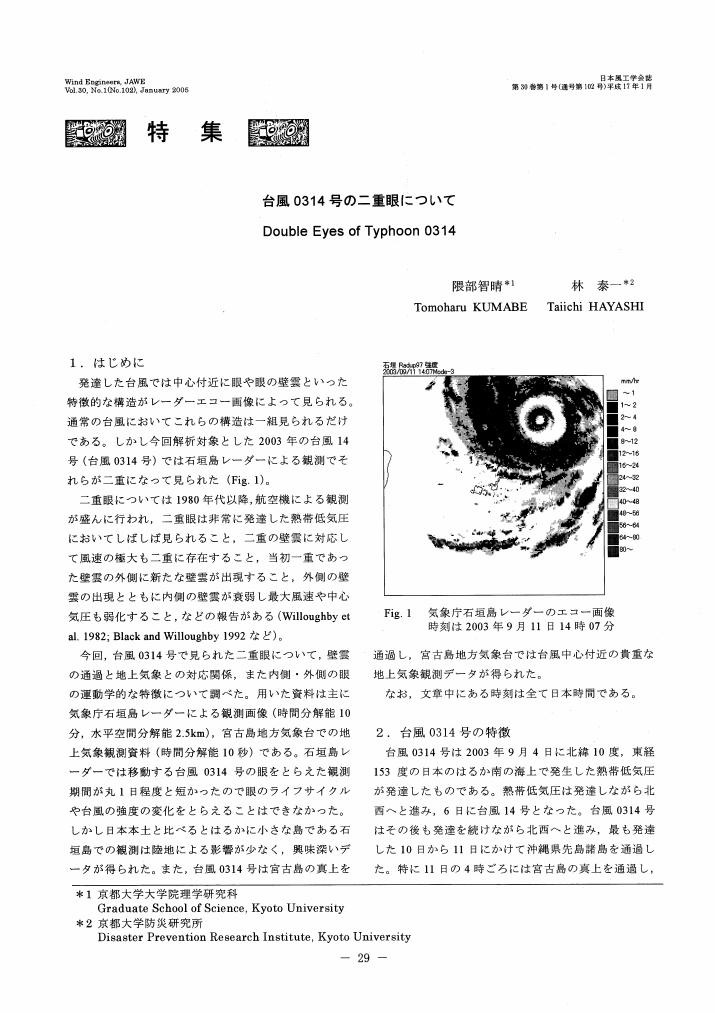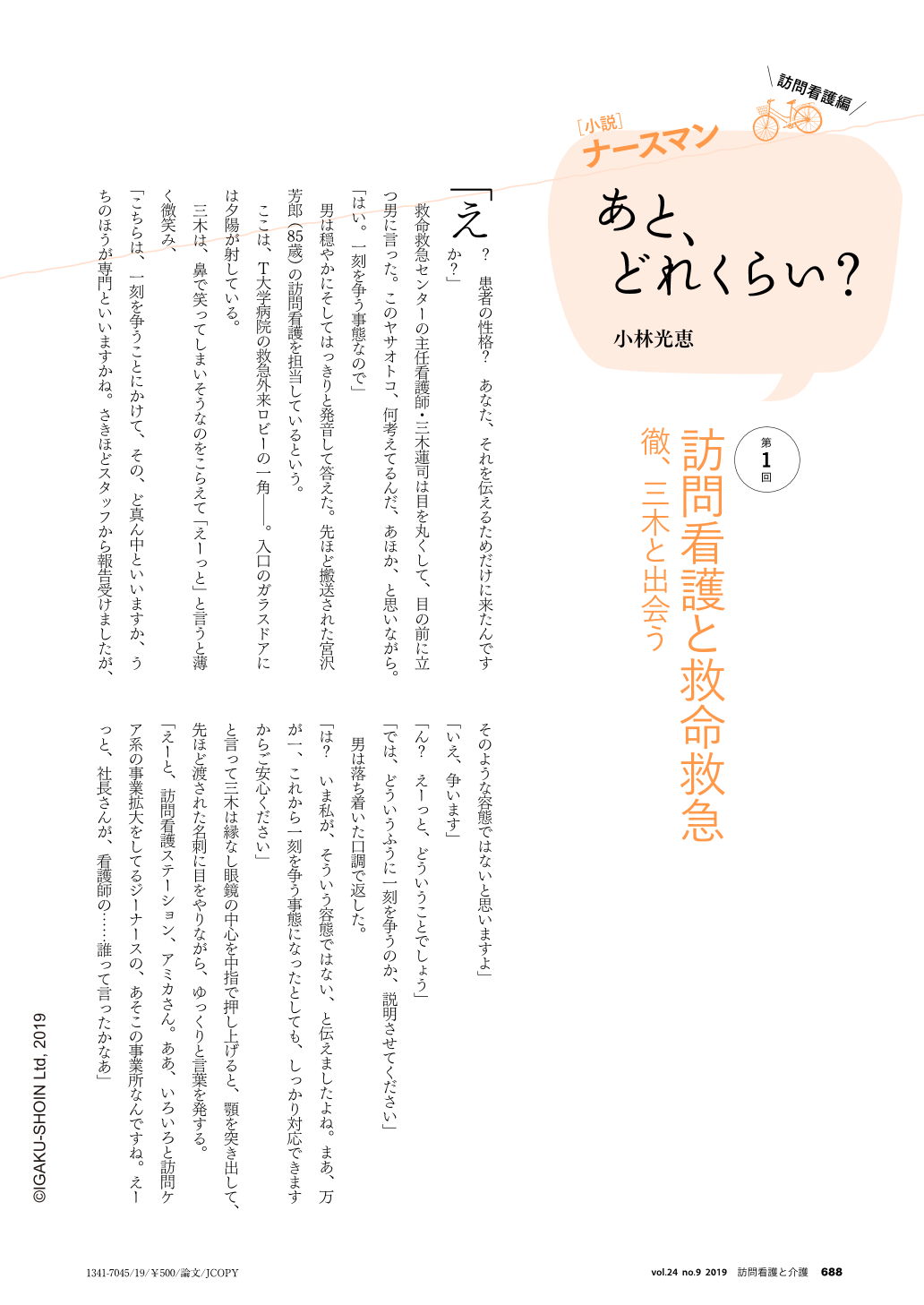3 0 0 0 OA 石川県におけるシタベニハゴロモの生態
- 著者
- 富沢 章 大宮 正太郎 福富 宏和 林 和美 石川 卓弥
- 出版者
- 日本昆虫学会
- 雑誌
- 昆蟲. ニューシリーズ (ISSN:13438794)
- 巻号頁・発行日
- vol.16, no.1, pp.3-14, 2013-01-05
シタベニハゴロモの野外における生態を調査した.本種は年1化で,卵越冬する.幼虫は5月下旬から8月初旬にかけて出現する.成虫は7月下旬から11月下旬まで認められ,寿命は3-4ヵ月と推定された.幼虫はおもに新梢部の枝や葉軸から吸汁するので枝先に多く,成虫は樹幹部に集団を形成する傾向が認められた.交尾および産卵行動は9月後半から11月まで認められ,夕方から夜間に行われた.卵は被覆物質で被われた卵塊としてシンジュの枝や幹の雨が直接当たらない下面に産み付けられた.幼虫・成虫を通しての寄主植物としてシンジュとセンダンが確認された.また,エゴノキとアカメガシワでは,成虫においてのみ樹幹部からの吸汁が認められた.
3 0 0 0 IR 認知地図の歪みの成分に関する一考察 - 金沢市中心部を事例として -
- 著者
- 若林 芳樹 伊藤 悟
- 出版者
- 東京地学協会 = Tokyo Geographical Society
- 雑誌
- 地學雜誌 (ISSN:0022135X)
- 巻号頁・発行日
- vol.103, no.3, pp.221-232, 1994-06-25
- 参考文献数
- 34
- 被引用文献数
- 4 6
Geographical approach to cognitive maps has mainly focused on measurement of their spatial patterns. Recently Lloyd (1989) devised a useful method for analyzing the components of distortions in cognitive maps by means of Euclidean regression. Until now, however, this method has not yet been validated. The purpose of this study was to reexamine his concepts about the distortions in cognitive maps and to test their validity.We pointed out several discrepancies between the concepts of distortions and their operational definitions given by Lloyd (1989). To overcome this problem, the absolute distortion that appears in the configuration before Euclidean regression ought to be distinguished from the systematic distortion that is measured by the parameters of Euclidean regression. While the systematic distortion that indicates a Euclidean property of the distortion can be explained by alignment and rotation heuristics (Tversky, 1981) and implicit scaling model (Holyoak and Mah, 1982), the relative distortion that remains after Euclidean regression cannot be explained by general theories. In addition, these geometrical components of distortion ought to be distinguished from statistical ones, namely, distortion (central tendency) and fuzziness (dispersion) defined by Gale (1982).On the basis of this conceptualization, we carried out an empirical analysis of the distortion in the cognitive map of Kanazawa City. The data used in this study were obtained by a conditional sketch mapping drawn from 113 students of Kanazawa University. Locations to be answered were 21 transportation nodes within the central part of the city known by more than 90 percent of the students. From these locations, two major landmarks of CBD were selected as reference points. Subjects were asked to indicate the remaining 19 locations on the legal-size sheet in which the two reference points were printed.We detected the absolute distortions, overlaying the cognitive maps for all samples on the actual map so as to fit the locations of two reference points into the actual ones. The patterns of the absolute distortion indicated that the amount of errors increased with distance from the reference points, and that the locations in cognitive maps commonly shifted outward from the actual ones. Specifically, these displaced locations in southern or eastern part of the city indicated a counterclockwise shift, which suggested a directional bias in cognitive maps.In order to separate the systematic distortion from the relative one, each of the cognitive configurations was fitted into the actual map by Euclidean regression. Parameter estimates of the scale change averaged 0.593, which suggested that cognitive maps were enlarged about twice the size of the actual map. Mean direction of the rotated angle amounted to-22.2 degrees, which implied that cognitive maps were rotated counterclockwise about 20 degrees from the actual map so as to coordinate the cardinal directions of the cognitive map with the actual one. This tendency can be due to the displacement of two river channels as major reference lines in Kanazawa from cardinal directions.After eliminating the systematic distortions by Euclidean regression, the actual map was overlaid with all the cognitive maps. The overlaid maps indicated that the local patterns of relative distortions reflected hierarchical structure of cognitive maps (Stevens and Coupe, 1978) although the amount of them was smaller than that of the systematic distortions.
- 著者
- 林 衛
- 巻号頁・発行日
- pp.1-26,
日本災害復興学会2018年度東京大会, 日程:2018年10月26日(金)~28日(日), 会場:東京大学本郷キャンパス
3 0 0 0 OA 易より観たる広田内閣 : 各大臣の運命予言
3 0 0 0 OA シートベルトによる胸骨骨折
- 著者
- 中村 英次郎 井口 竹彦 中村 太郎 山田 秀大 七森 和久 酒井 祐一 林 義裕 畑田 和男
- 出版者
- West-Japanese Society of Orthopedics & Traumatology
- 雑誌
- 整形外科と災害外科 (ISSN:00371033)
- 巻号頁・発行日
- vol.47, no.2, pp.704-707, 1998-03-25 (Released:2010-02-25)
- 参考文献数
- 9
Five cases of the fracture of the sternum due to use of a seat belt were reported. According to the Fowler's classification, our cases were classified as TYPE: 1 case, Type IV: 3 cases and Type VIII: 1 case. With regard to four cases (type I and IV), the mechanism of the fracture was direct violence.A case associated with the injuries of interspinal ligaments of the thoracic spine, the mechanism of the fracture was indirect violence as flexion-compression injury. All cases were treated with rest and immobilization. The importance of radiographic examination on the sternum in patient of seat belt injury.
3 0 0 0 環太平洋民族誌にみる肖像頭蓋骨
3 0 0 0 OA 都道府県公安委員会に対する苦情申出制度について
- 著者
- 小林 良樹
- 出版者
- 日本犯罪社会学会
- 雑誌
- 犯罪社会学研究 (ISSN:0386460X)
- 巻号頁・発行日
- vol.37, pp.119-133, 2012-10-31 (Released:2017-03-31)
本稿は,都道府県公安委員会に対する苦情申出制度に関して,「警察に対する国民の信頼の改善方策」の観点から考察を加えることを目的とする.具体的には,「警察に対する国民の信頼を改善するための有効な方策の一つとして都道府県公安委員会に対する苦情申出制度の活性化が考えられる」,「そのためには同制度に対する国民の認知を向上させることが肝要である」との仮説の検証を試みる.分析・検証の結果,「苦情申出制度の利用は極めて低調である」,「同制度に対する国民の認知が極めて低いことがその原因の一つと考えられる」旨がある程度検証された.したがって,苦情申出制度に対する国民の認知を高めることは同制度の利用率の向上につながり,ひいては警察に対する国民の信頼の向上に資するものと推察される.警察に対する国民の信頼の現状は必ずしも盤石ではない.今後とも警察が私企業,NPO/NGO,地域社会等の多様なアクターとの連携を一層強化するとともに,新たな犯罪情勢に対応するべく捜査権限の強化を目指すのであれば,信頼の一層の向上に努める必要がある.こうした信頼改善の努力の中で,苦情申出制度の改善は避けては通れない問題と考えられる.
3 0 0 0 OA 日米で食薬区分の異なるメラトニンのインターネットを介した個人輸入における安全性情報の比較
- 著者
- 大塚 邦子 野村 靖幸 内田 直樹 安原 一 小林 真一
- 出版者
- 日本社会薬学会
- 雑誌
- 社会薬学 (ISSN:09110585)
- 巻号頁・発行日
- vol.33, no.1, pp.21-29, 2014-06-10 (Released:2015-08-11)
- 参考文献数
- 47
Classification of food and pharmaceutical products are different. In the proper use of pharmaceutical products, it is essential for a medical consumer to receive the drug information about effectiveness, safety and quality of it. On the other hand, since legal classification between medicines and dietary supplements was based their cultures, the classification of each drug is different in each country. Melatonin is a hormone produced by the pineal gland and used for improvement of the jet lag. We searched melatonin product information of Japan and the United States by using Internet search mainly and investigated the relationship between amount of product information and product classification. Melatonin is classified as a dietary supplement in the United States, the product information of efficacy and safety is displayed as “Supplement Facts” and the use of melatonin in children is not recommended. On the other hand, melatonin is classified as a pharmaceutical product in Japan, but is not produced in Japan. Therefore, it is difficult to have it for Japanese customers, and then they personally import using the Internet with their self-responsibility. However it is difficult to obtain its appropriate information for consumers, because of the regulation of the Pharmaceutical Affairs Law. It has been reported that the poisoning accident by the excessive intake of melatonin already. It will increase the risk of the health problem to purchase melatonin through the Internet more. Therefore, we concluded that Internet purchase of Medicines had a high risk for Japanese customers since there was not sufficient drug information.
3 0 0 0 書評 永田えり子著『道徳派フェミニズム宣言』
- 著者
- 小林 盾
- 出版者
- 数理社会学会
- 雑誌
- 理論と方法 (ISSN:09131442)
- 巻号頁・発行日
- vol.13, no.2, pp.250-252, 1999-01
3 0 0 0 OA 観光写真調査法による観光地の魅力評価
- 著者
- 林 幸史
- 出版者
- 日本社会心理学会
- 雑誌
- 社会心理学研究 (ISSN:09161503)
- 巻号頁・発行日
- pp.1819, (Released:2019-10-21)
- 参考文献数
- 39
The purpose of this study is to use the travel photo method (TPM) to reveal the kinds of tourist attractions that cause travelers to be attracted to tourist destinations. In the investigation, we obtained the cooperation of 75 travelers. As a result of analyzing 742 supplied photographs, European and American travelers assessed the attractiveness of Nara through the subjects of temple and shrine architecture, modern architecture, statues of Buddha, and Japanese homes, while Asian tourists did so through subjects such as food and shops, lanterns, and torii (gateways to Shinto shrines). Among the Japanese travelers, the group who had visited many times assessed the attractiveness of Nara through the subjects of stone ruins and flora, while the group who had visited fewer times did so through the subjects of fellow travelers, temple and shrine architecture, and deer. Further, the results showed that travelers' tourism experiences in Nara can be broadly divided into three types. Based on these, we considered the practical significance of assessments of the attractiveness of tourist destinations using TPM.
3 0 0 0 IR "鬼"の性別についての一考察 : 「読みがたり」に登場する"鬼"の話から
- 著者
- 林 鎭代
- 出版者
- 関西国際大学
- 雑誌
- 教育総合研究叢書 (ISSN:18829937)
- 巻号頁・発行日
- no.5, pp.69-88, 2012-03
昔話に登場する"鬼は",「一本または二本の角を頭に生やし」「大きな体は赤や青や黒の色をしている」「毛深く力は強い」などと表現され,男性としてイメージされる場合が多い。"鬼"は,山奥に住まい,村に来ては食べ物や財産,娘をさらっていく悪しき存在であり,話の結末では人間に退治されることとなっている。「読みがたり」47巻は,2004年から2005年にかけて誕生した。それらは,以前から地方にあった昔話を,子どもへの教育的活用を意図として再編集されたものである。「読みがたり」には,わずかではあるが女性の"鬼"も登場している。そして,人間に退治されない結末の話も収録されている。女性の"鬼"は,老女とされているが,男性の"鬼"については年齢を示す表現はない。"鬼"の性別と話の結末には,関連はあるのか。"鬼"の性別によって,子どもに伝えたい内容は異なってくるのか。「読みがたり」から,"鬼"の性別による影響を探った。
3 0 0 0 OA 台風0314号の二重眼について
- 著者
- 隈部 智晴 林 泰一
- 出版者
- Japan Association for Wind Engineering
- 雑誌
- 日本風工学会誌 (ISSN:09121935)
- 巻号頁・発行日
- vol.2005, no.102, pp.29-32, 2005-01-31 (Released:2010-06-04)
- 参考文献数
- 4
3 0 0 0 音波を用いたMIMO通信の実現に向けた検討
- 著者
- 林 大介 柴山 秀雄
- 出版者
- 一般社団法人電子情報通信学会
- 雑誌
- 電子情報通信学会技術研究報告. EA, 応用音響 (ISSN:09135685)
- 巻号頁・発行日
- vol.108, no.333, pp.1-6, 2008-11-27
- 参考文献数
- 6
水中や地中など,電波の使用が困難な環境における無線通信の手段として,音波を用いたMIMO通信の実現に向けた研究を行っている.MIMO(Multiple Input Multiple Output)とは,複数の送受信素子を用いることによって,通信速度や信頼性の向上を実現する方式であり,近年電波を用いた無線通信の分野において盛んに研究されている.我々は音波を用いた通信に本方式を応用し,音響通信の通信速度向上を目指したいと考える.本報告では,その実現に向けた基礎的検討として,伝搬状況の異なる5つの環境においてチャネル応答を測定し,その環境においてMIMO通信を行った状態をシミュレーションにより検証した.音波を用いたMIMO通信の特徴や問題点などについて報告する.
- 著者
- 林 幹也
- 出版者
- 明星大学心理学研究室
- 雑誌
- 明星大学心理学年報 = Meisei university annual report on psychological research (ISSN:02884704)
- 巻号頁・発行日
- no.33, pp.9-18, 2015
3 0 0 0 5Gコアネットワーク向けアプリケーション処理連接基盤
- 著者
- 佐藤 友範 渡邊 大記 林 和輝 近藤 賢郎 寺岡 文男
- 雑誌
- 研究報告電子化知的財産・社会基盤(EIP) (ISSN:21888647)
- 巻号頁・発行日
- vol.2019-EIP-85, no.18, pp.1-8, 2019-09-12
第 5 世代移動通信方式 (5G) では超高信頼低遅延通信や大容量モバイル通信などの高機能な通信サービスが提供され,自動運転や高精細な拡張現実感 (AR) のようなサービスが普及すると考えられている.本稿はエッジサーバ,フォグサーバ,クラウドサーバを含むような 5G コアネットワークを 1 台の計算機のように見せる処理基盤として Application Function Chaining (AFC) を提案する.AFC は高精細 AR のようなアプリケーションを小機能(Application Function; AF) ごとに分割し,AF の連接によってアプリケーションを構成する.アプリケーションは Pub/Sub 方式または HTTP リクエストにより AFC を利用する.AFC 内ではアプリケーションメッセージ単位で AF が適用される.本稿では,プロトタイプ実装により AFC の基本性能を評価した.AFC の確立では AF の設置よりも AF の連接にかかる時間的オーバーヘッドが大きく,AFC 上でのデータ通信ではアプリケーションメッセージ長が10KB 以上の場合で 90% 以上の帯域使用率となった.
3 0 0 0 OA MMSEと時計描画テストのスコアリングは認知症診断精度を向上させる
- 著者
- 西野 真佐美 中森 正博 今村 栄次 小川 加菜美 黒瀬 雅子 平田 明子 三森 康世 若林 伸一
- 出版者
- 一般社団法人 日本臨床衛生検査技師会
- 雑誌
- 医学検査 (ISSN:09158669)
- 巻号頁・発行日
- vol.68, no.3, pp.424-429, 2019-07-25 (Released:2019-07-27)
- 参考文献数
- 12
時計描画テスト(Clock Drawing Test; CDT)は,検査に対する抵抗が少ないため認知症スクリーニングとして頻用されている。今回,CDTのスコアリングを行いその有用性を検討した。2016年10月~2017年4月に当院外来にてCDT,ミニメンタルステート検査(Mini-Mental State Examination; MMSE)ともに実施した,連続156名で検討した。スコアリングはFreedman法(15点満点)を用い2名で判定した。年齢78.2 ± 8.7歳,女性87名,診断はアルツハイマー型認知症(Alzheimer’s disease; AD)54名,レビー小体型認知症(dementia with Lewy body; DLB)6名,血管性認知症12名,混合型認知症15名,その他の認知症16名,軽度認知障害16名,認知機能正常者37名であった。CDT総得点とMMSEは有意な相関がみられた(r = 0.58, p < 0.001)。ROC解析では,CDT総得点に関して認知症とのカットオフ値11/10(感度50.5%,特異度96.2%,AUC 0.78,p < 0.001)であった。CDT下位項目で検討すると,ADでは針の記入で,DLBでは数字の記入で失点する傾向がみられた。CDTのスコアリングはMMSEを併用して行うことで感度を上げることができ,MMSEと有意な相関がみられ評価の妥当性が示された。また,疾患によって失点パターンに差異がみられることから診断の一助になりうる可能性が示唆された。
- 著者
- 小宮山 謙一郎 増本 愛 西原 冬実 小林 威仁 杣 知行 萩原 弘一 金澤 實 永田 真
- 出版者
- 一般社団法人 日本アレルギー学会
- 雑誌
- アレルギー (ISSN:00214884)
- 巻号頁・発行日
- vol.62, no.12, pp.1631-1641, 2013-12-30 (Released:2017-02-10)
【背景・目的】迅速IgE測定システムとして開発されたImmunoCAP^[○!R] Rapidを用いてアレルギー疾患患者の特異的IgE抗体を測定し,プリックテスト(SPT)と比較することでその有用性を検討した.【方法】2010年9月から2012年2月までにアレルギー疾患が疑われた患者83名を対象とした.患者背景は年齢中央値43歳で,喘息53例,アレルギー性鼻炎が42例であった.【結果】全アレルゲンの陽性率はImmunoCAP^[○!R] Rapidに比べSPTが高い陽性率(22.5% vs 26.5%, p<0.05)となったが,スギ抗原ではImmunoCAP^[○!R] Rapidが陽性率は同等であり(68.7% vs 55.4%, p=0.07), 鼻炎患者においては有意に高い陽性率(90.4% vs 71.4%, p<0.05)を示した. SPT陽性をベースにしたImmunoCAP^[○!R] Rapidの感度66.9%, 特異度93.4%, 陽性・陰性一致率86.4%であった.アレルゲン別に検討すると,スギとダニの各々の感度は93.5%, 73.8%, 特異度は62.2%, 92.7%と高値を示し,診断効率は86.4%, 83.1%と良好であった.また,IgEの判定結果と皮膚反応(紅斑,膨疹)の相関性もみられた(r=0.645, 0.657).【結語】SPTに比べImmunoCAP^[○!R] Rapidのアレルゲン同定率はやや劣るが,主要アレルゲンであるスギやダニ患者のアレルゲン同定には有用と考えられた.
3 0 0 0 訪問看護と救命救急—徹、三木と出会う
- 著者
- 小林 光恵
- 出版者
- 医学書院
- 雑誌
- 訪問看護と介護 (ISSN:13417045)
- 巻号頁・発行日
- vol.24, no.9, pp.688-692, 2019-09-15
「え? 患者の性格? あなた、それを伝えるためだけに来たんですか?」 救命救急センターの主任看護師・三木蓮司は目を丸くして、目の前に立つ男に言った。このヤサオトコ、何考えてるんだ、あほか、と思いながら。
3 0 0 0 学術情報検索における閲覧論文の文献種別による分析
インターネットの普及と文献の電子化に伴い,CiNii Articles などの学術論文検索が日常的な学習や研究で重要な役割を果たすようになった.ただし,研究者以外の多彩なユーザに,文献がどのように利用されているかは明らかではない.本稿では,学術情報検索サービスのユーザの閲覧行動を,何人が閲覧したかで重要度を示す閲覧人数と,ある論文を閲覧したユーザが他にどのくらい論文を閲覧したかで内容の普遍性を示す閲覧普遍度の2つの指標と,学術および一般出版物の種別を用いて分析する.まず,CiNii Articles のサービスの利用履歴から,ユーザが閲覧した各文献の閲覧人数と閲覧普遍度を求める.次に,計算機科学分野のクエリの検索結果を閲覧人数と閲覧普遍度で順位付けした後に,該当分野における主要3学会が発行・開催する論文誌,研究会,大会・シンポジウム,そして一般的な出版社の雑誌などの異なる特性を表す種別を付与することで,各指標の順位に伴う文献種別の傾向や特性の変化を分析する.
本研究は、4年間の研究期間において下記の5点を一体的に進める。(1)教育プログラムの評価と改善の好循環システムの先進事例を検討するため、米国・英国等の大学への訪問調査を行い、優れた循環システムの要件を抽出、(2)日本の大学の全国的な量的調査により、教育プログラムの評価と改善に関わる実態分析や主要な問題を特定、(3)学習成果測定や教育プログラムの評価を推進している日本の大学への訪問調査、(4)日本の大学において教育プログラムの評価と改善の好循環システムを形成する際に考慮すべき点やシステム構築上の要件等の抽出・整理、(5)好循環システムを組織的に構築するための具体的な手法をティップスの形式にまとめ公表。



